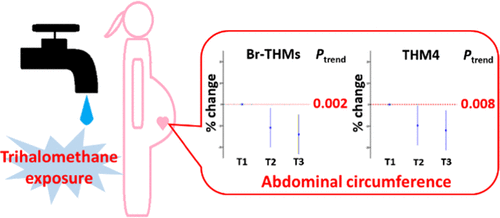当前位置:
X-MOL 学术
›
Environ. Sci. Technol.
›
论文详情
Our official English website, www.x-mol.net, welcomes your
feedback! (Note: you will need to create a separate account there.)
Prenatal Exposure to Disinfection Byproducts and Intrauterine Growth in a Chinese Cohort
Environmental Science & Technology ( IF 10.8 ) Pub Date : 2021-11-23 , DOI: 10.1021/acs.est.1c04926 Chong Liu 1, 2 , Yang Sun 3, 4 , Vicente Mustieles 5, 6 , Ying-Jun Chen 7 , Li-Li Huang 8 , Yan-Ling Deng 1, 2 , Yi-Xin Wang 9 , Wen-Qing Lu 1, 2 , Carmen Messerlian 3, 4
Environmental Science & Technology ( IF 10.8 ) Pub Date : 2021-11-23 , DOI: 10.1021/acs.est.1c04926 Chong Liu 1, 2 , Yang Sun 3, 4 , Vicente Mustieles 5, 6 , Ying-Jun Chen 7 , Li-Li Huang 8 , Yan-Ling Deng 1, 2 , Yi-Xin Wang 9 , Wen-Qing Lu 1, 2 , Carmen Messerlian 3, 4
Affiliation

|
Disinfection byproduct (DBP) exposure has been associated with birth size, pregnancy oxidative stress, and other adverse perinatal outcomes. However, little is known about the potential effect of prenatal DBP exposure on intrauterine growth. The present study included 1516 pregnant women from the Xiaogan Disinfection By-Products (XGDBP) birth cohort who were measured for four blood trihalomethanes [i.e., chloroform (TCM), bromodichloromethane (BDCM), dibromochloromethane (DBCM), and bromoform (TBM)] and two urinary haloacetic acids [i.e., dichloroacetic acid (DCAA) and trichloroacetic acid (TCAA)] across pregnancy trimesters. Second- and third-trimester fetal ultrasound measures of the abdominal circumference (AC), head circumference, biparietal diameter, femur length, and estimated fetal weight and birth weight were converted into z-scores. After adjusting for potential confounders, linear mixed models showed a decreasing AC z-score across tertiles of blood brominated THM (Br-THMs, the sum of BDCM, DBCM, and TBM) and total THM (THM4, the sum of Br-THMs and TCM) concentrations (both p for trend <0.01). We also observed a decreasing AC z-score across categories of blood TBM during pregnancy trimesters (p for trend = 0.03). Urinary haloacetic acids were unrelated to fetal growth parameters. In summary, prenatal exposure to THMs, particularly during the first trimester, was associated with reduced fetal abdominal circumference.
更新日期:2021-12-07











































 京公网安备 11010802027423号
京公网安备 11010802027423号